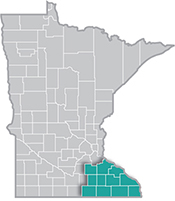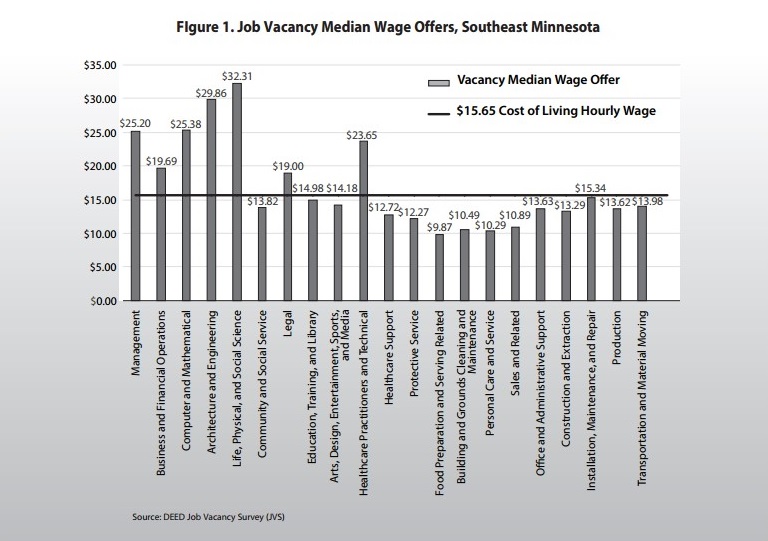 Southeast Minnesota is a health care and agricultural powerhouse. The region is home to the renowned Mayo Clinic and some of the world's most recognized food companies and brands.
Southeast Minnesota is a health care and agricultural powerhouse. The region is home to the renowned Mayo Clinic and some of the world's most recognized food companies and brands.
Advanced manufacturing is especially strong here, with machinery, chemicals, and electronics among the top products.
Want the freshest data delivered by email? Subscribe to our regional newsletters.
4/26/2017 9:47:04 AM
Meeting the monetary threshold to afford the basic cost of living needs is not always easy, especially when it comes to the high price tags on things such as housing, food, and transportation. Southeast Minnesota is no different than other areas in the state when it comes to those financial realities.
As seen in Table 1, a two-parent household with one child and one parent working full-time while the other works part-time needs to make an annual wage of $48,828 in order to meet these basic cost of living needs in Southeast Minnesota. There is, of course, variation when looking at this at the county level.
In theory the highest annual cost would be for those living in Olmsted County, the center of the Rochester Metropolitan Statistical Area. However, the highest cost of living is surprisingly found in Rice County. In fact, Olmsted County ranks fourth highest in the Southeast Region, behind Rice, Goodhue, and Dodge counties.

Job seekers looking for opportunities in Southeast Minnesota will find a strong economy, with over 8,000 vacancies in the region in 2016. However, many of them have median wage offers that fall below what is needed to meet the basic cost of living needs for a typical family in the region. As seen in Figure 1, there are only seven occupational groups that have vacancies with median wage offers that meet the cost of living threshold, while the remaining 15 fall below, including the groups with the largest number of current job openings.

The recent vacancy data show other issues with the characteristics of the job postings. Many of the occupational groups with the most openings do not pay the hourly wage needed to meet the basic cost of living needs for a typical family. However, it is possible that those wages may meet the needs of other household compositions, such as a single person or a partnered couple without children.
Not only are the median wage offers across all vacancies below $15.65, the top six groups with the most vacancies share this characteristic, and it’s not until health care practitioners and technical occupations, with 488 vacancies, that we see the first median wage offers that make the cut. To put it into context, that’s almost two-thirds of the current vacancies that don’t fit the bill.
Some of these low-paying vacancies also have high percentages that are part-time, temporary, or seasonal, leading to a double whammy of low hourly wage offers and part-time hours. These lead to lower earnings from fewer hours in general, jobs that only last for a certain period of time, or jobs that have seasonal layoffs. For example, of the 1,458 vacancies in food preparation and serving-related occupations, which had the most openings in the region, 64 percent (933 vacancies) are part-time. As shown in the above figure, this set of occupations has a median wage offer of only $9.87 per hour.
Likewise, about two-thirds of the openings for sales and related and personal care and service occupations were part-time, and wage offers were below $11.00 per hour. Education, training, and library openings, which have a median wage offer that is slightly below what needs to be earned to meet the basic cost of living needs for a typical family, also see a high number of vacancies (861), but of those, 51 percent (439 vacancies) are temporary or seasonal.
Thus, earning potential is affected by a lack of full-time year-round employment. While the cost of living in Southeast Minnesota is lower than some other regions, and there are indeed people employed in jobs that pay enough or more than enough to cover the basic cost of living needs for a typical family, there are other families that aren’t earning enough to meet those needs. While cost of living needs vary depending on family composition and how many hours one or both parents work each week, Southeast Minnesota has its work cut out for itself to help fill the gap between what workers are being paid and what they need to be able to afford to live in the region.
For more on cost-of-living and job vacancies in Southeast Minnesota, contact Mark Schultz.